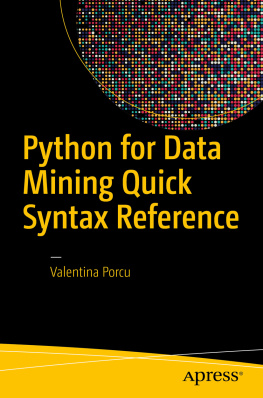About the Reviewers
Aniket Maithani is a budding engineer and is currently pursuing a B.Tech in Computer Science and Engineering from Amity University. He is primarily interested in contributing to open source projects and believes in the FOSS/FLOSS ideology. He has been working in the field of embedded systems and open hardware for the last two years. Apart from coding and hacking around with regular stuff, he loves to play the guitar and write on his blog. He can be reached at <>.
There are a few people I would like to thank for helping me out. Firstly, my dad, who introduced me to the world of computers! Also, I would like to thank my professor Mr. Manoj Baliyan and my senior Mr. Anuvrat Parashar, who introduced me to the world of Python and its awesomeness. I would also like to thank my mentor, Satyakaam Goswami for always guiding me. Lastly, God Almighty for his kind grace and blessings.
Atmaram Shetye is a Computer Science and Engineering Graduate from Goa University. Having worked in a variety of companies, from start-ups to large multinational enterprises, he is a strong supporter of polyglot programming. He has spent most of his time programming in Python, while also using C, Objective-C, C++, and JavaScript at work. His areas of interest include artificial intelligence and machine learning. He is currently working as a Principal Software Engineer at CA Technologies, Bangalore.
Giuseppe Vettigli is a data scientist who has worked in the research industry and academia for many years. His work is focused on the development of machine learning models and applications to utilize information from structured and unstructured data. He also writes about scientific computing and data visualization in Python on his blog at http://glowingpython.blogspot.com.
Ron Zacharski completed a PhD in Computer Science at the University of Minnesota, focusing on artificial intelligence and computational linguistics. He is the author of the free online Python-based book, A Programmer's Guide to Data Mining: The Ancient Art of the Numerati (http://www.guidetodatamining.com). He is an Associate Professor of Computer Science at the University of Mary Washington. Ron is a novice Zen Buddhist monk.
www.PacktPub.com
Support files, eBooks, discount offers, and more
You might want to visit www.PacktPub.com for support files and downloads related to your book.
Did you know that Packt offers eBook versions of every book published, with PDF and ePub files available? You can upgrade to the eBook version at > for more details.
At www.PacktPub.com, you can also read a collection of free technical articles, sign up for a range of free newsletters and receive exclusive discounts and offers on Packt books and eBooks.
http://PacktLib.PacktPub.com
Do you need instant solutions to your IT questions? PacktLib is Packt's online digital book library. Here, you can access, read and search across Packt's entire library of books.
Why subscribe?
- Fully searchable across every book published by Packt
- Copy and paste, print and bookmark content
- On demand and accessible via web browser
Free access for Packt account holders
If you have an account with Packt at www.PacktPub.com, you can use this to access PacktLib today and view nine entirely free books. Simply use your login credentials for immediate access.
Preface
Greetings, this is Chad Adams, and welcome to Learning Python Data Visualization . In this book, we will cover the basics of generating dynamic charts and general graphics with code using the Python programming language. We will use the pygal library, a simple yet powerful graphing library written for Python, to explore the different types of charts we can create for various kinds of data.
We will also review the Python language itself and discuss working with file I/O and cover topics on working with data. We will then parse that data into a chart to create a dynamic charting application. We will also touch on more popular (and more advanced) libraries such as matplotlib and Plotly and build charts using these libraries and explore their features.
With this book, we will explore and build data visualizations using the basic toolsets used in many popular charting applications for the scientific, financial, medical, and pharmaceutical industries.
What this book covers


















